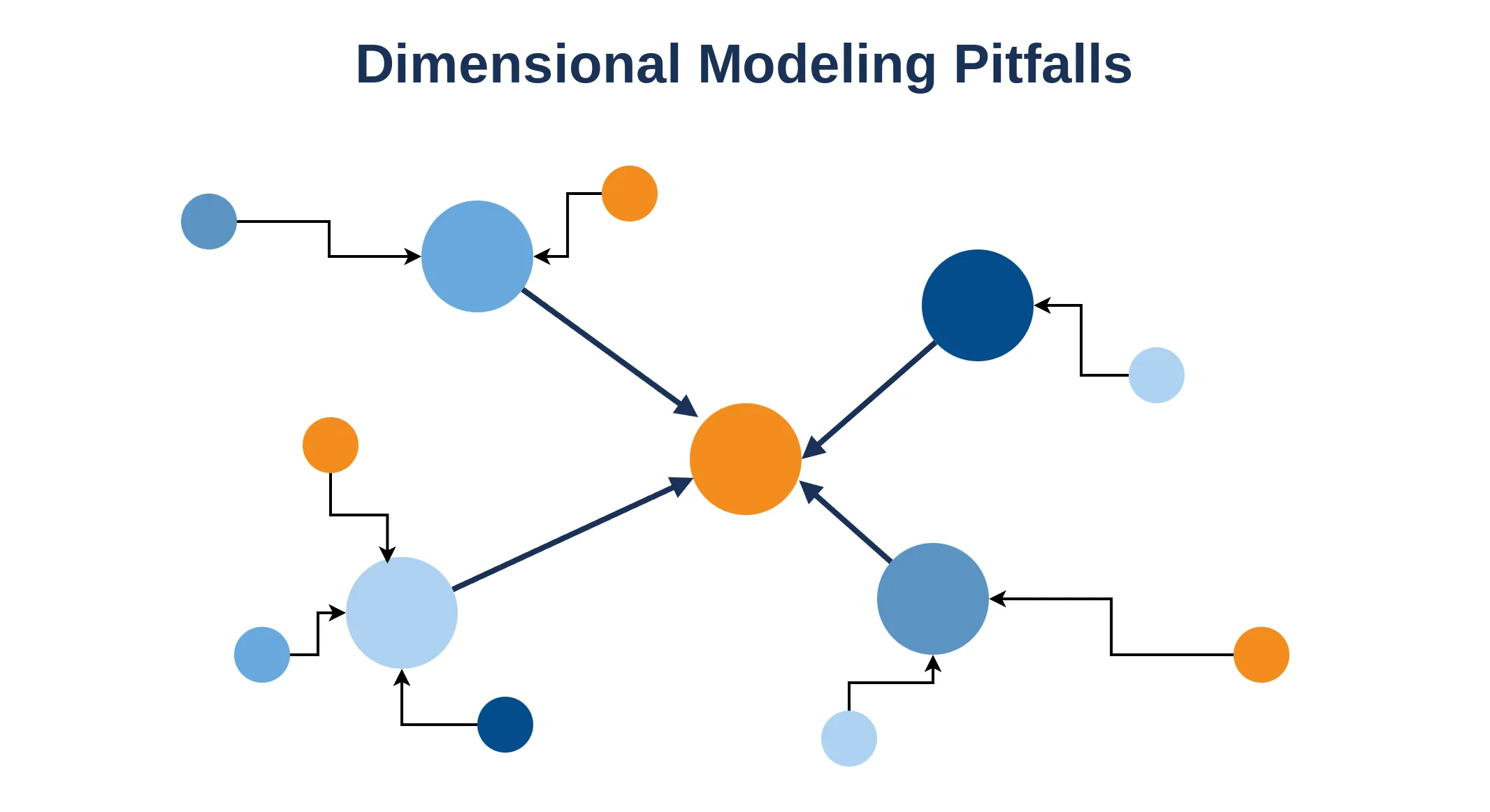
 Donny Peeters
Donny Peeters
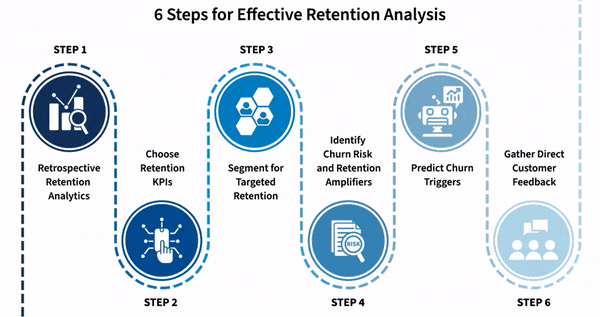
Customer retention analytics and understanding churn rates have become critical to any successful company's strategy. Customer retention goes beyond just acquiring new customers; it focuses on retaining and nurturing the existing customer base, which often proves more cost-effective and profitable.
Churn, the loss of customers, can have a substantial financial impact, making it imperative to analyze and combat the underlying reasons behind it. This blog provides a comprehensive guide on customer retention and churn analysis, offering a step-by-step approach to effectively monitor, evaluate, and improve customer retention.
By reading this blog, you can learn to:
Customer retention is a fundamental business strategy focused on preserving as many customers as possible and strengthening customer relationships. It hinges on maintaining a high customer retention rate, indicating the number of loyal customers sustained over a specific time frame. This rate is directly influenced by customer churn (the count of lost customers) and customer acquisition (the addition of new customers). In essence, customer retention strategies encompass diverse approaches to cultivating customer loyalty and satisfaction.
Every business is focused on acquiring new customers. However, it is sometimes forgotten that new customers are difficult and expensive. Caring for the customers you have is crucial to be successful.
It’s 5-25X more expensive to acquire a new customer as it is to retain an existing one
– HBR
You’ll achieve many benefits by making customer retention a critical strategy in your business. Here, we have listed out the main ones.
Customers encouraged to remain loyal—those who perceive themselves as heard, understood, and valued—are significantly more inclined to experience satisfaction with your services. Contented customers are far more likely to advocate for your brand to their network, amplifying overall customer acquisition metrics.
Customer Lifetime Value (CLV) represents a customer’s overall value to a business throughout their association. Understanding CLV is pivotal for enterprises as it enables them to formulate effective strategies for acquiring new customers and preserving existing ones, all while upholding profit margins.
Your most loyal customers will more likely be happy to share insights into the things you’re doing well but also things you could be doing better. Allowing you to gain insight into your service directly and over extended time frames. Customer feedback is an immensely crucial resource in ongoing business enhancement, particularly in addressing potential gaps in the customer experience that might otherwise go unnoticed.
Any facet of your business that receives a discerning and constructive evaluation should experience positive effects. Proactively establishing a customer retention program, whether through introducing customer loyalty initiatives, price adjustments, or enhancements, will reduce customer churn. In simpler terms, as your retention rates increase, your churn rates decrease, fostering a more efficient and lucrative business overall.
A common mistake is implementing tactics to reduce churn immediately without knowing why your customers churned. An intelligent customer retention analysis provides insights into areas where improvements are required. Understanding the “where” and “why” of customer churn empowers you to identify vulnerabilities within your marketing and retention strategies and address them promptly.
Retention analysis provides insights into the number of customers who churn and the reasons for their departure. This approach allows you to pinpoint specific behaviors associated with churn and gather direct feedback.
Identifying the timing and circumstances under which customers choose to discontinue their engagement with your business can reveal weaknesses in your strategy. Concurrently, feedback is a direct source of information regarding the factors contributing to a customer’s decision to churn.
To maximize the benefits of retention analysis, it’s crucial to conduct it regularly. Customer behavior evolves, as does your product offering. Gaining a comprehensive understanding requires ongoing and consistent analysis of customer cohorts.
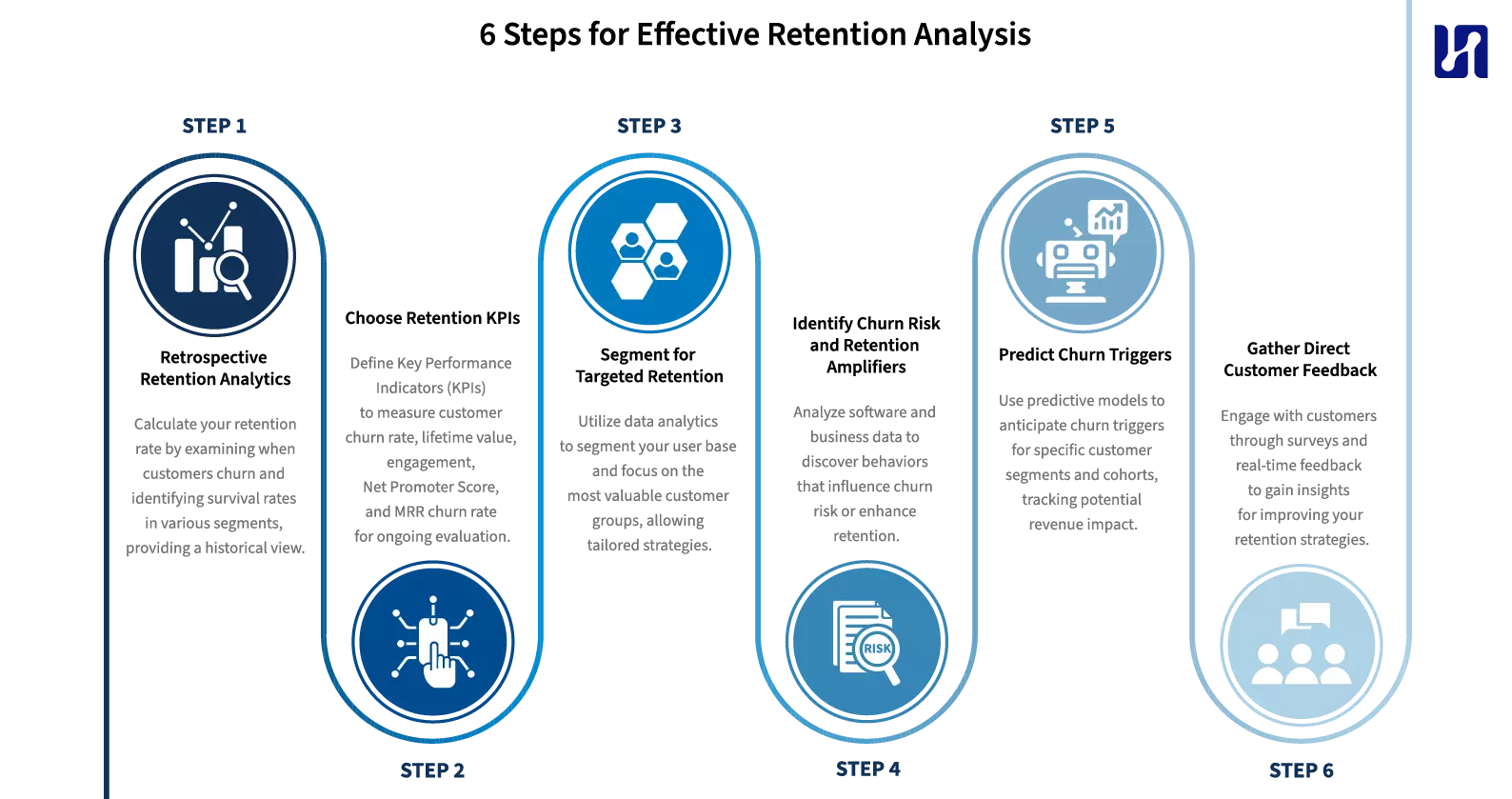
Step 1. Retrospective retention analytics - Calculate your retention rate
In the initial step of this retention analysis process, we delve into retrospective retention analytics, focusing on calculating the retention rate. This approach involves measuring when customers churn and the revelation of survival rates within distinct customer segments. It serves as a foundational point in gaining a deeper understanding of your customer base and a great starting point for examining customer churn. However, it’s worth noting that this method primarily looks at historical data, and its ad-hoc nature means it may not provide real-time insights. Completing this step will guide the decision to continue with ongoing and continuous retention analysis.
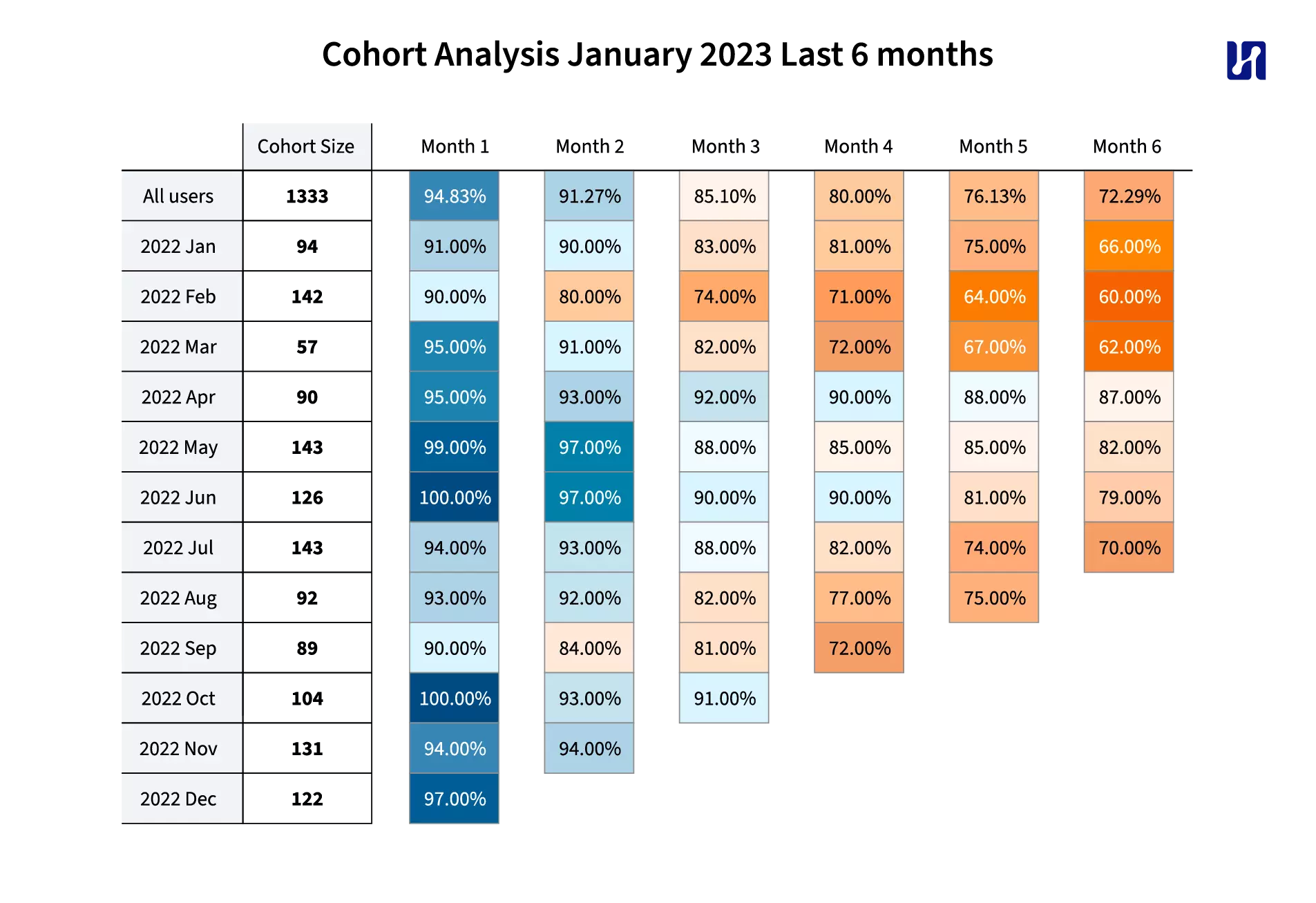
The above graphic shows an example of a cohort analysis; in this graph, we analyze the number of new users per cohort, where each month of the year is a cohort, and we look at their churn rate throughout their first six months. Note that the number of users in each cohort drops over time, but some cohorts and some months have less drop-off than others. Further analysis could explain the influential factors here that indicate whether users are likely to churn and how we could improve these numbers.
Step 2. Choose retention KPIs and Measure them
Before delving into analytics and periodic churn analysis, it’s essential to establish the objectives you aim to accomplish. An excellent approach to this is the utilization of Key Performance Indicators (KPIs).
After completing a retrospective analysis, you are now prepared to define your personalized KPIs for continuously measuring your customer base. Implementing KPIs provides an effective means of continually evaluating and optimizing your business’s health.
You’ll want to consider the following KPIs:
To elevate your customer retention strategies, analyzing these KPI-related objectives is imperative. Different businesses may prioritize unique metrics tied to customer engagement, such as the number of upgrades, frequency of feedback, participation in loyalty programs, and more. The key to making KPIs effective is their frequent measurement through automated reports, ensuring that vital insights are readily accessible and not subject to manual oversights.
Step 3: Segment to focus on retaining the right customers
Effective customer retention hinges on identifying and focusing on the right customer segments. Segmenting your user base is a powerful tool for uncovering the most valuable customer groups and directing marketing efforts where they yield the highest returns.
Leveraging data analytics to categorize individuals into distinct groups enables you to discern the unique engagement patterns of each segment with your brand and product. This, in turn, allows for granular analysis of subgroups, leading to the implementation of tailored communication and service strategies aimed at bolstering customer retention among your most valuable customers.
You can unveil your different segments by analyzing your customer base in different groups, for example, using demographics, lifestyles, product preferences within each category, customer frequency, and value of purchases. This will reveal which customers are the primary revenue drivers, and aids in discerning which customers may be too costly in relation to the revenue they generate, guiding your focus on the most profitable segments.
Step 4: Identifying Churn Risk and Retention Amplifiers
A meticulous examination of your software and business operations can reveal specific behaviors and variables that increase the risk of churn or enhance customer retention. These behaviors are pivotal triggers that influence a customer’s decision to extend their subscription or cancel their plan.
Successful SaaS businesses widely employ this strategy, like Slack and Notion; patterns within the data often unveil straightforward indicators. These may include a minimum threshold of monthly logins or a particular level of engagement with critical features within a defined time frame. Such patterns can signify a customer’s inclination to renew their subscription. For more insights on this subject, our PLG blog provides additional valuable information.
Analyzing these behaviors and variables enables businesses to proactively address the elements contributing to churn risk while strengthening strategies promoting customer retention.
Step 5: Predicting Churn Triggers for Customer Segments and Cohorts
In this phase, you’ll harness predictive capabilities to anticipate potential churn triggers within specific customer segments and cohorts. This predictive analysis empowers you to forecast whether certain groups or subsets of your customer base might be approaching a churn risk. Employing sophisticated predictive models provides a data-driven glimpse into the future, enabling you to implement measures to retain these at-risk customers proactively. Example measures you could take are contacting them directly by email or phone, or offering them a discount package.
Additionally, tracking the potential financial repercussions associated with these customers is essential, allowing for a comprehensive assessment of the impact of churn on revenue and facilitating informed decision-making.
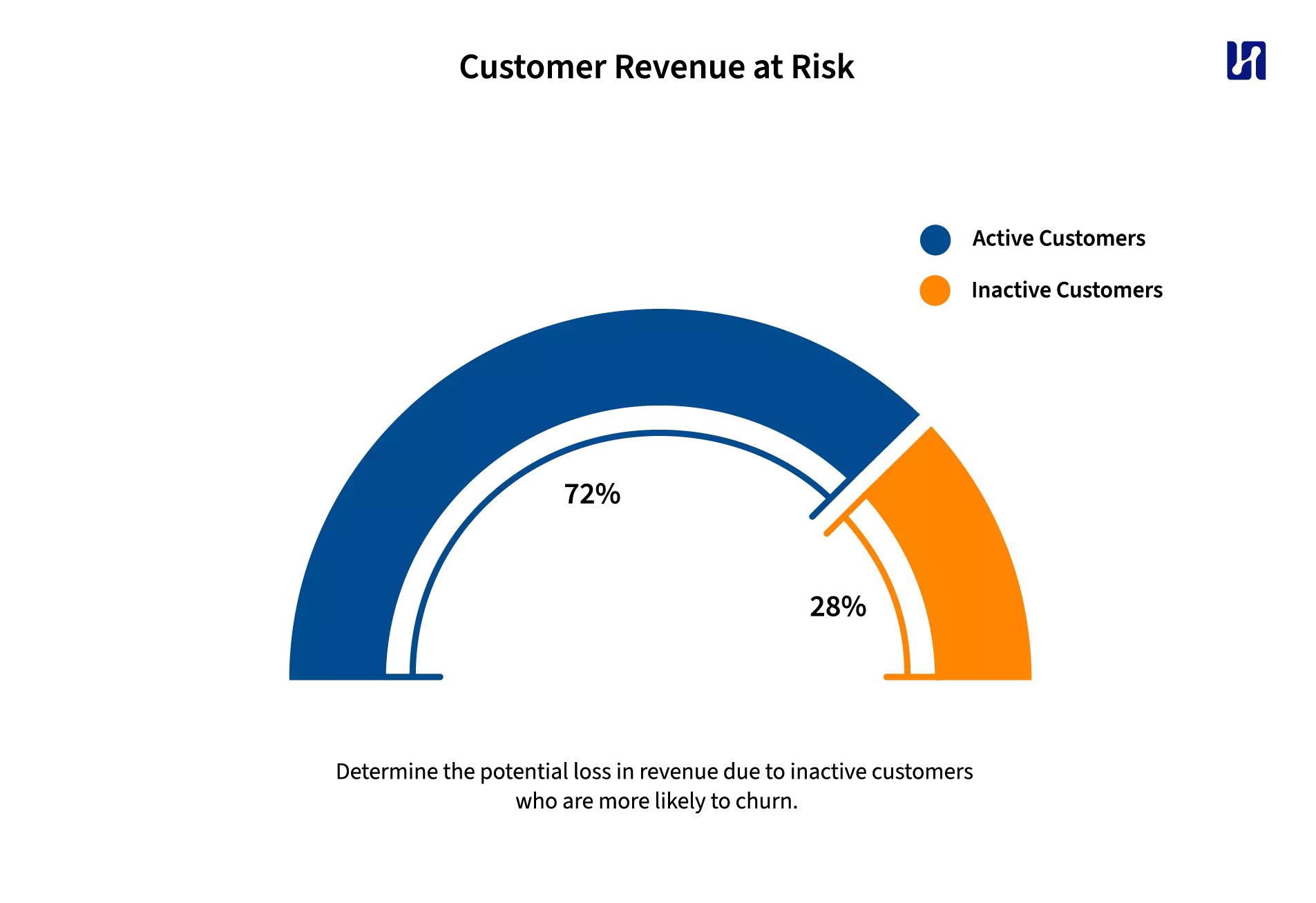
Step 6: Gathering Direct Customer Feedback
Engaging with your customers directly through surveys or real-time feedback requests while interacting with your product is a valuable practice. This direct interaction yields valuable insights into the aspects of your business that are performing well and those that may require improvement. Leveraging customer feedback offers a window into your strengths and weaknesses and provides opportunities to enhance your customer retention strategies based on their suggestions and preferences. The key is to collect quantitative and qualitative data by reaching out to your customers directly.
Now that we’ve established a practical step-by-step plan for retention analytics, we will elaborate on some best practices to keep in mind if you embark on this journey.
There are quite some pitfalls when implementing retention analytics, and here we’ve shared our view on the best practices to keep in mind. We’ve split it up into 6 points, both technical and less technical.
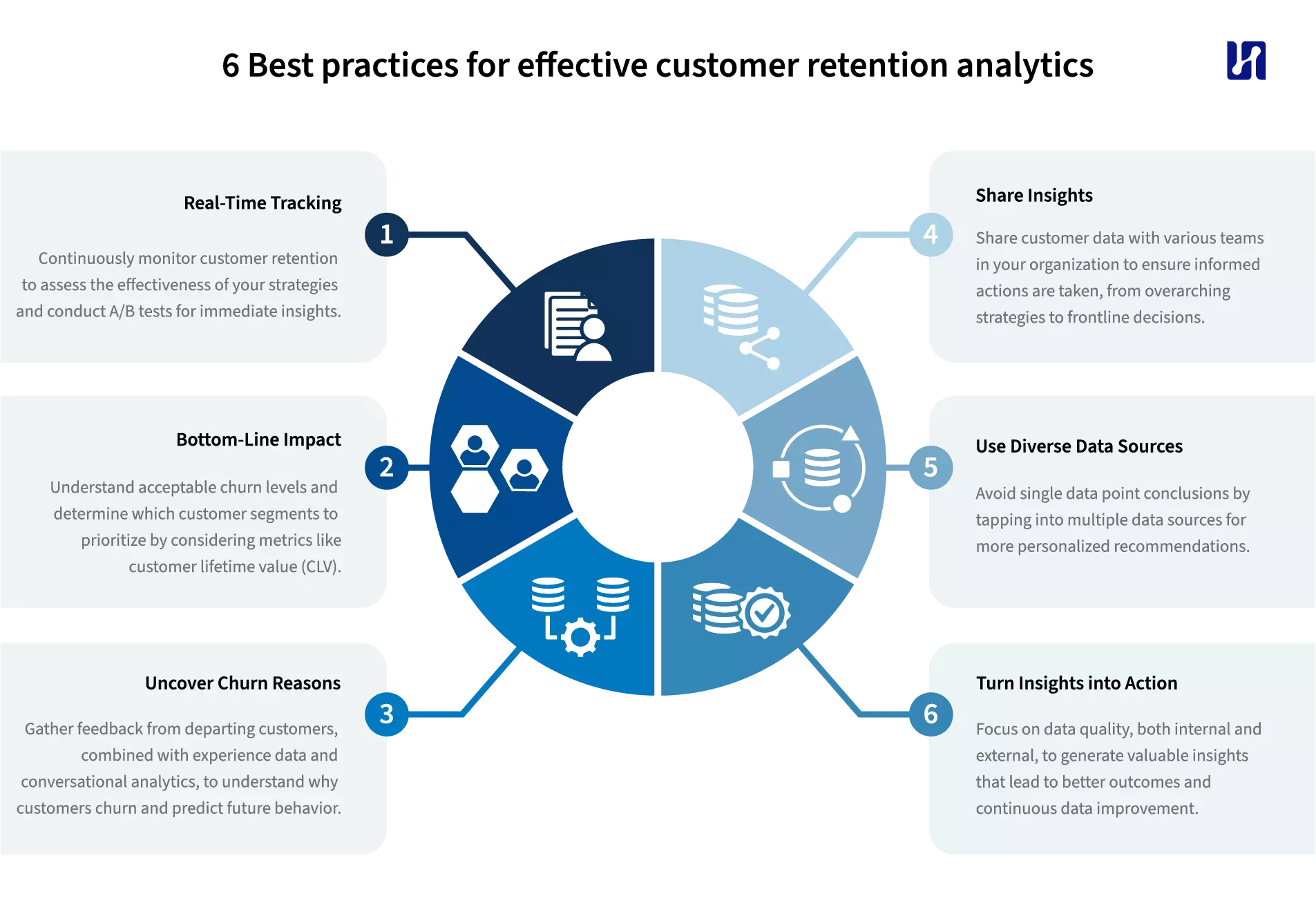
Maintaining a real-time grasp of your customer retention performance is paramount. To understand the efficacy of your retention strategies, monitoring customer churn continuously is crucial. While some organizations opt for periodic reporting, typically quarterly or annual, leading analytics teams prefer to possess an “always-on” data stream, enabling them to stay updated daily on shifts in their retention rates. This will also allow you to A/B test newly implemented features, providing direct measurements of their impact on customer satisfaction and retention.
As previously emphasized, comprehending the acceptable threshold for churn is fundamental. Determining which customer segments you are willing to let go of is equally vital. Integrating operational data, such as customer lifetime value (CLV), in making these determinations proves highly beneficial. CLV is a valuable metric for guiding decisions about where to invest efforts in retaining specific customer groups.
Optimizing customer retention requires an understanding of why customers churn. Whether you have an existing retention system in place or not, gathering feedback from departing customers is essential. This feedback, combined with experience data, offers insights into the root causes of churn. Leveraging conversational analytics can delve deeper into understanding the emotional aspects, effort exerted, and sentiments experienced by customers during their interactions with your brand. Such insights can help predict the likelihood of churn and illuminate the underlying reasons driving customer actions.
Given the multifaceted nature of customer retention, sharing valuable customer data with various teams within your organization is imperative. This ensures that all relevant departments can take informed actions based on this data. Compile a comprehensive list of customer-facing teams that play a pivotal role in retention and provide them with the necessary information to make well-informed decisions. This collaborative approach spans from the design of overarching retention strategies to the frontlines, where moment-to-moment decisions influence customer satisfaction and, consequently, retention. Harmonizing your customer experience program with existing systems used by these teams empowers them to take the most suitable actions for enhancing customer experiences in their daily operations.
Pragmatically, avoid drawing conclusions based on a single data point. For instance, just because someone bought one pair of men’s underwear doesn’t necessarily mean they desire similar product recommendations. It’s possible they bought the underwear for a family member as a Christmas gift. Therefore, tapping into multiple data sources allows for more nuanced and personalized recommendations.
The quality of insights is intrinsically linked to the data quality at your disposal. Enhancing data accuracy leads to more robust insights, which, in turn, result in better outcomes. Ongoing efforts to refine data collection processes are essential, spanning both internal data collection, such as usage events, and the strategic solicitation of the right questions from your customers about your services.
Additionally, consider incorporating external data sources where relevant; for example, for one of our clients, the gas price significantly impacted the churn behavior of people using their software, and integrating gas prices into the analytical framework provided deeper context and better predictions. The collection and management of high-quality data represent an ongoing and indispensable endeavor.
Mastering customer retention analytics and understanding churn rates is essential to any thriving business strategy. The significance of customer retention goes beyond acquiring new customers; it revolves around nurturing and preserving your existing customer base, which can be more cost-effective and, ultimately, more profitable. Churn, or the loss of customers, can have a substantial financial impact, underscoring the need to analyze and address the underlying causes effectively.
This comprehensive guide offers a systematic approach to monitor, evaluate, and enhance customer retention strategies; we’ve dived into the following points:

Maximilian is a machine learning enthusiast, experienced data engineer, and co-founder of BiteStreams. In his free-time he listens to electronic music and is into photography.
Read moreEnjoyed reading this post? Check out our other articles.

 Donny Peeters
Donny Peeters
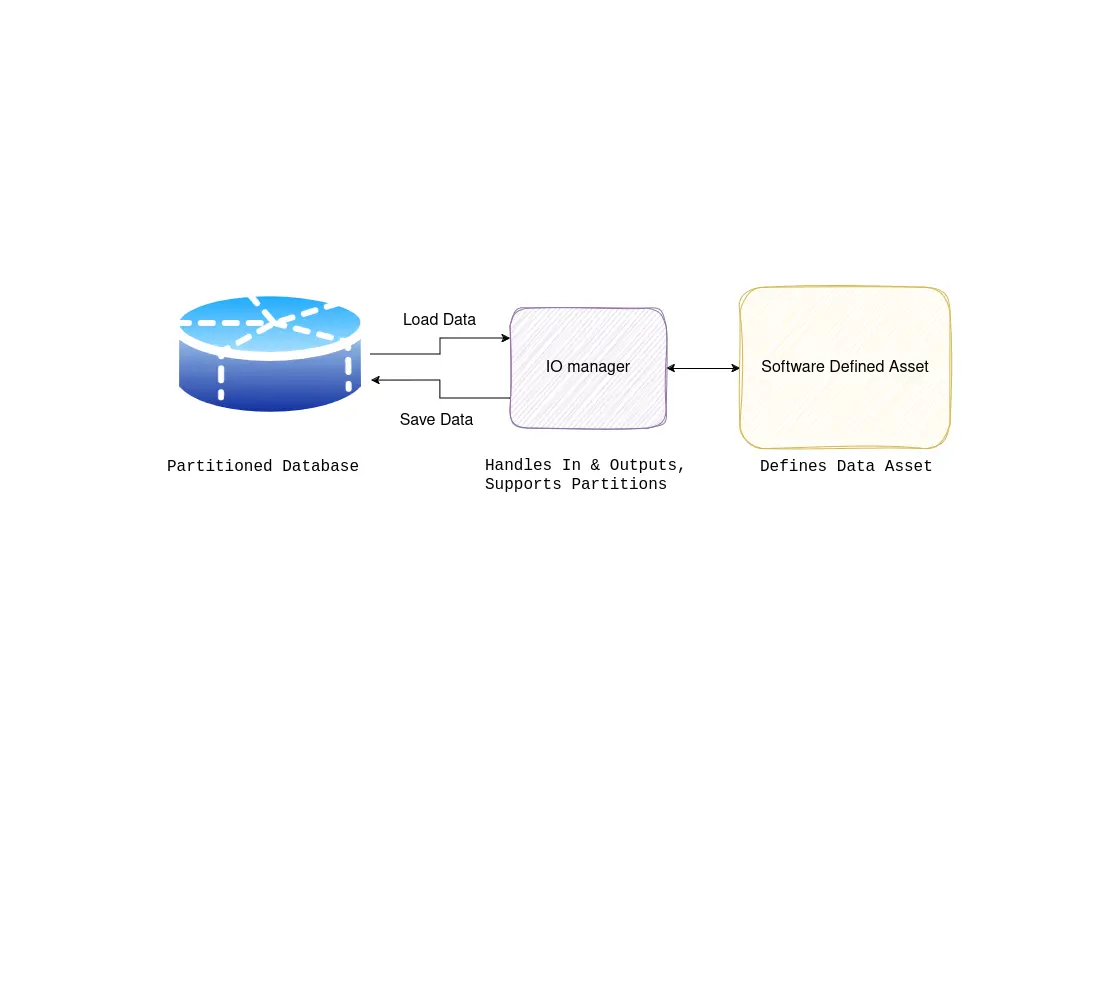
 Maximilian Filtenborg
Maximilian Filtenborg
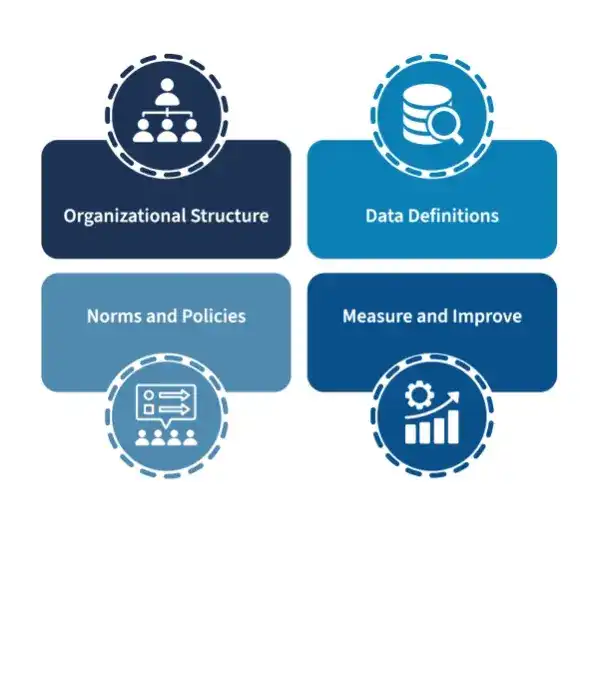
 Maximilian Filtenborg
Maximilian Filtenborg
Feel free to contact us, we don't bite.
Contact us